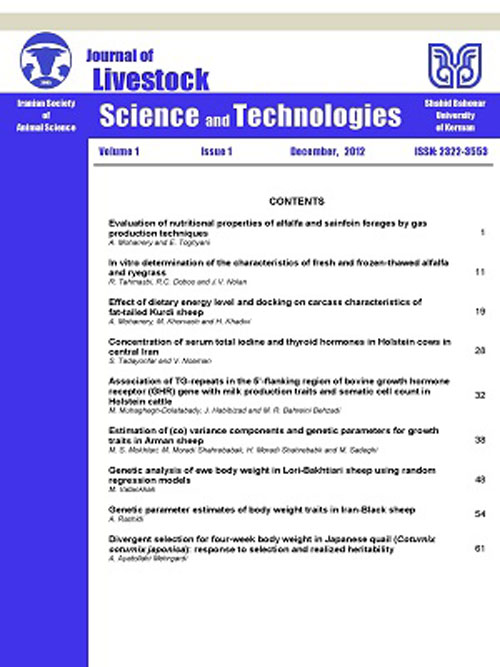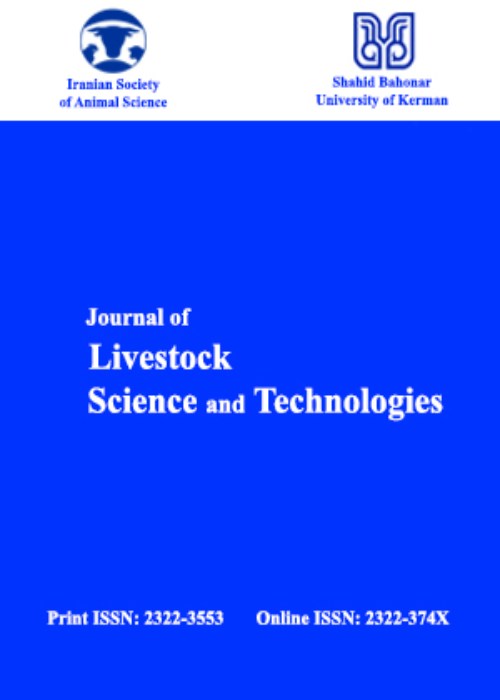فهرست مطالب

Journal of Livestock Science and Technology
Volume:6 Issue: 1, Apr 2018
- تاریخ انتشار: 1397/03/30
- تعداد عناوین: 8
-
-
Pages 1-8The objective of this study was to evaluate the effects of different doses of pistachio by-product (PBP) extracts supplemented with alfalfa hay (AH) or barley grain (BG) on microbial fermentation in an in vitro fermentation system. The total extracted phenolic compounds were 36.96, 65.78, 67.02 and 8.85% and total extracted tannin contents were 37.11, 59.64, 56.87 and 7.55% when PBP was extracted with water, ethanol 70%, methanol 80% and a mixture of chloroform and methanol, respectively. Adding the mixture of chloroform and methanol extracts to both substrates reduced the gas production (PKeywords: phenolic compounds, tannin, ammonia, VFAs, in vitro
-
Pages 9-17This experiment was conducted to determine the possibility of replacing part of the barley grain by hydroponic barley fodder (HBF), and evaluating its effect on digestibility, rumen parameters, microbial protein synthesis and blood parameters in sheep. Four male Kermani sheep, 18-month-old (34.7 ± 1 kg live weight) were randomly assigned to a change over 4 × 4 design and fed the experimental diets for 21 d; 16 d for adaptation and 5 d for sample collection. Hydroponic-grown barley fodder replaced barley grain in the experimental diets. The experimental diets were: 1) control diet (without hydroponic barley fodder), 2) diet containing 7% of hydroponic barley fodder, 3) diet containing 14% of hydroponic barley fodder and 4) diet containing 21% of hydroponic barley fodder. Results showed that dry matter intake (DMI), nitrogen intake and retention and digestibility of nutrients increased (PKeywords: feed, forage, germination, grain, nutrients
-
Pages 19-29This study investigated the effects of replacing soybean meal (SM) with canola meal (CM) and decreasing crude protein (ýCP) levels in CM based diets on performance of dairy cows when different sources of processed grains and CM were used. Canola meal was untreated or roasted at 130°C for 30 minutes and grains sources (corn and barley) were either ground or steamed-flaked. Eight Holstein cows (ý2nd lactations; 42 ± 2 d in milk; 600ý±ý20 kg body weight) were used in a 4×4 Latin square design with 4 treatments. Treatments wereý a control diet based on SM containing 16.5% CP (SM), or 1 of 3 diets based on CM as (1) untreated CM ground grain sources containing 17.7% dietary CP (CM-17.7), 2) treated CM ýground grain sources containing 16.5 % dietary CP (CM-16.5), and 3) treated CM steam ýflaked grain sources containing 15.3 % dietary CP (CM-15.3). Diets were iso-energetic, however, the estimated metabolizable protein (MP) and Lys: Met ratio were the highest in the SM diet but both values were gradually decreased with reducing dietary CP in the CM dietsý. Feeding CM diets led to similar intake, milk yield and efficiency, as well as nitrogen (N) efficiency (milk N/N intake) as compared to SM diet. However, milk fat content tended to be lower in SM diet than in CM diets. Digestibility of dry matter (DM) and neutral detergent fiber (NDF) was lower in cows fed CM-17.7 than those fed either SM, or CM-16.5, CM-15.3 diets. Decreasing dietary CP in the CM diets had no significant effects on DM intake, milk production or milk composition, whereas N efficiency was linearly increased. Different diets or dietary CP level had no significant effect on plasma parameters. In conclusion, the present study indicated that replacing SM with CM resulted in similar milk yield and efficiency. Decreasing dietary CP from 17.7 to 15.3 % by feeding a mixture of treated CM and steam flaked grain sources did not affect milk production but improved N efficiency of dairy cows in early lactation.Keywords: canola meal, crude protein, dairy cows, soybean meal
-
Pages 31-38The aim of the current study was to evaluate the effects of lavender (Lavandula angustifolia) powder as an herbal feed additive on growth performance, carcass traits, meat quality, jejunal histomorphology, and ileal microbial population in broiler chickens. A total of two hundred twenty one day-old male broiler chicks were used in a completely randomized design with five treatments and four replicates (11 birds per replicate) for 42 days. Experimental diets consisted of a basal diet without any additives as control group and the basal diet containing flavophospholipol (0.02 %) or 3 levels of lavender powder (0.3, 1 or 1.7 %). Body weight, feed intake and feed conversion ratio were measured during the starter (1- 10 d), grower (11- 24 d) and finisher (25-42 d) periods. The results showed that lavender powder (at 1 % level) significantly increased feed intake during the finisher and entire rearing periods. Also, body weight gain and feed conversion ratio improved during the grower, finisher and entire rearing periods. Lavender powder significantly decreased (PKeywords: broiler, flavophospholipol, lavender, meat quality, performance
-
Pages 39-47This experiment was conducted to study the effect of Aflatoxins (AF) on broiler performance, organ weight, plasma characteristics, protein digestibility, and metabolizable energy of the diets. Dietary treatments were: 1) control diet based on corn and soybean meal; 2, 3 and 4) control diet plus 1 mg kg-1 AF, 1 mg kg-1 AF and 0.25% mycosorb, and 0.25% Mycosorb, respectively. The results in the Aflatoxins and Aflatoxins mycosorb treatments showed that dietary AF, significantly decreased the feed intake and weight gain as compared to the control diet (P0.05). Aflatoxin resulted in the proventriculus enlargement, increased liver weight and AF deposition in the liver and breast muscle (PKeywords: Aflatoxin, broiler, Mycosorb, protein digestibility
-
Pages 49-56A ten-week trial was carried out to determine the effect of different levels of nano-calcium carbonate (NCC) on egg production performance and egg quality. A completely randomized experiment was designed comprising 6 treatments, each with 4 replicates of 5 hens. Groups 1 and 2 were fed diets containing 8.06% and 6.045% calcium carbonate (CC) as positive and negative control respectively. Groups 3, 4, 5 and 6 received diets with 4.03% CC plus 2.015, 1.01, 0.252 and 0.126% NCC respectively. Egg production at 32 wks of age was significantly reduced by the lowest dietary supplementation with NCC (T6) (P0.05). The lowest egg shape index was recorded for the birds fed T6 at 31 and 33 wks of age (PKeywords: nano, calcium carbonate, laying hen, performance traits, egg quality
-
Pages 57-64The purpose of the present study was to assess the effect of modified camel milk (MCAM) and skim cow milk (SCOM) on semen quality of INRA180 and Boujaâd ram breeds, stored at 15°C for up to 24 hours. Semen samples were collected from eleven mature rams (6 from INRA180 and 5 from Boujaâd rams) and extended in SCOM vs MCAM, to reach a final concentration of 0.8×109 spermatozoa/mL, and stored at 15°C for 24 hours. The quality assessment was performed at different storage periods (0, 2, 8 and 24 hours). The results showed that the stored sperm quality varied significantly from breed to breed and sperm response to milk extenders differed between ram breeds. The MCAM showed a clear beneficial effect on stored sperm quality, compared to SCOM especially for motility, lipid peroxidation, and membrane integrity. Additional studies are needed to evaluate the pregnancy rate after insemination with stored semen.Keywords: camel milk, ram semen, ram breed, chilled semen
-
Pages 65-76Brucella melitensis, as a pathogenic gram-negative intracellular bacterium, causes brucellosis in animals and humans. According to literature, the B. melitensis outer membrane protein 31 (Omp31) is considered as an important vaccine candidate against brucellosis. The aim of the current study was to compare three different expression constructs containing B. melitensis Omp31 antigen using bioinformatics analysis approaches to facilitate choosing the best immunogenic construct. The coding sequence of Omp31 gene was PCR amplified, TA cloned and sequenced. The obtained DNA sequence was in silico cloned in pcDNA3.1/Hygro (), pcDNA3.1/His A and pSecTag2/Hygro mammalian expression vectors using CLC Main Workbench 5.5 software. The Omp31 gene was successfully cloned into the pTZ57R/T vector, and recombination was confirmed by colony PCR and sequencing. Comparison of the obtained Omp31 sequence with other Omp31 gene sequences showed high similarities. Bioinformatics analysis of three different mammalian expression vectors harboring Omp31 gene made it possible to choose the best immunogenic structure for further studies in order to design effective DNA vaccines against brucellosis.Keywords: bioinformatics, Brucella melitensis, in silico cloning, Omp31


